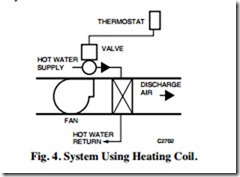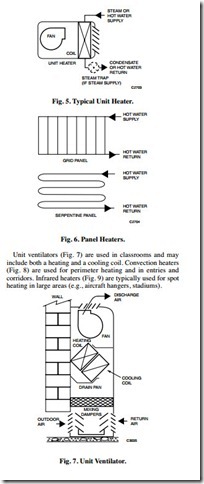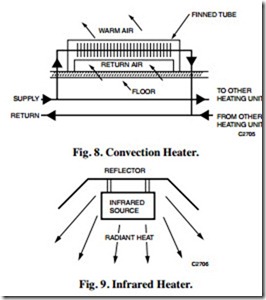HEATING EQUIPMENT
Selecting the proper heating equipment depends on many factors, including cost and availability of fuels, building size and use, climate, and initial and operating cost trade-offs. Primary sources of heat include gas, oil, wood, coal, electrical, and solar energy. Sometimes a combination of sources is most economical. Boilers are typically fueled by gas and may have the option of switching to oil during periods of high demand. Solar heat can be used as an alternate or supplementary source with any type of fuel.
A similar control scheme would apply to a steam coil. If steam or hot water is chosen to distribute the heat energy, high- efficiency boilers may be used to reduce life-cycle cost. Water generally is used more often than steam to transmit heat energy from the boiler to the coils or terminal units, because water requires fewer safety measures and is typically more efficient, especially in mild climates.
An air handling system provides heat by moving an air stream across a coil containing a heating medium, across an electric heating coil, or through a furnace. Unit heaters (Fig. 5) are typically used in shops, storage areas, stairwells, and docks. Panel heaters (Fig. 6) are typically used for heating floors and are usually installed in a slab or floor structure, but may be installed in a wall or ceiling.
Unit ventilators (Fig. 7) are used in classrooms and may include both a heating and a cooling coil. Convection heaters (Fig. 8) are used for perimeter heating and in entries and corridors. Infrared heaters (Fig. 9) are typically used for spot heating in large areas (e.g., aircraft hangers, stadiums).
In mild climates, heat can be provided by a coil in the central air handling system or by a heat pump. Heat pumps have the advantage of switching between heating and cooling modes as required. Rooftop units provide packaged heating and cooling. Heating in a rooftop unit is usually by a gas- or oil- fired furnace or an electric heat coil. Steam and hot water coils are available as well. Perimeter heat is often required in colder climates, particularly under large windows.
A heat pump uses standard refrigeration components and a reversing valve to provide both heating and cooling within the same unit. In the heating mode, the flow of refrigerant through the coils is reversed to deliver heat from a heat source to the conditioned space. When a heat pump is used to exchange heat from the interior of a building to the perimeter, no additional heat source is needed.
A heat-recovery system is often used in buildings where a significant quantity of outdoor air is used. Several types of heat-recovery systems are available including heat pumps, runaround systems, rotary heat exchangers, and heat pipes.
In a runaround system, coils are installed in the outdoor air supply duct and the exhaust air duct. A pump circulates the medium (water or glycol) between the coils so that medium heated by the exhaust air preheats the outdoor air entering the system.
A rotary heat exchanger is a large wheel filled with metal mesh. One half of the wheel is in the outdoor air intake and the other half, in the exhaust air duct. As the wheel rotates, the metal mesh absorbs heat from the exhaust air and dissipates it in the intake air.
in the warm exhaust air, and the vapor rises toward the higher end in the cool outdoor air, where it gives up the heat of vaporization and condenses. A wick carries the liquid refrigerant back to the warm end, where the cycle repeats. A heat pipe requires no energy input. For cooling, the process is reversed by tilting the pipe the other way.
Controls may be pneumatic, electric, electronic, digital, or a combination. Satisfactory control can be achieved using independent control loops on each system. Maximum operating efficiency and comfort levels can be achieved with a control system which adjusts the central system operation to the demands of the zones. Such a system can save enough in operating costs to pay for itself in a short time.


